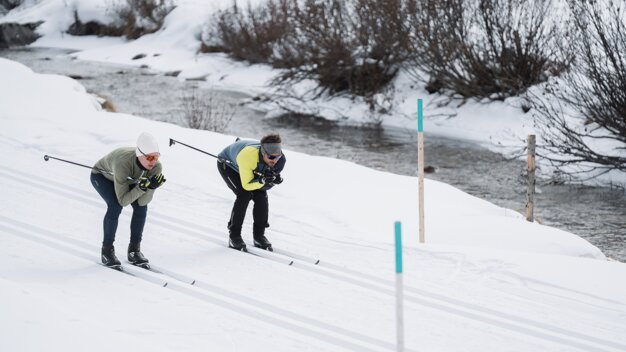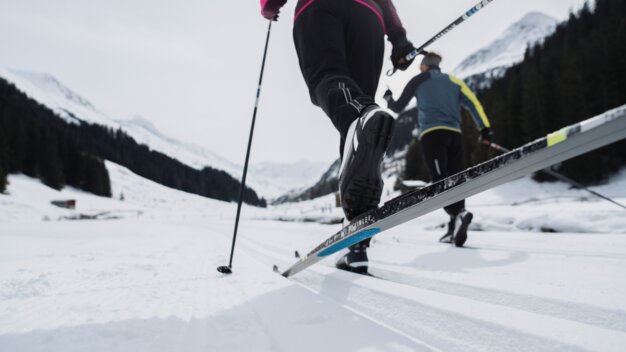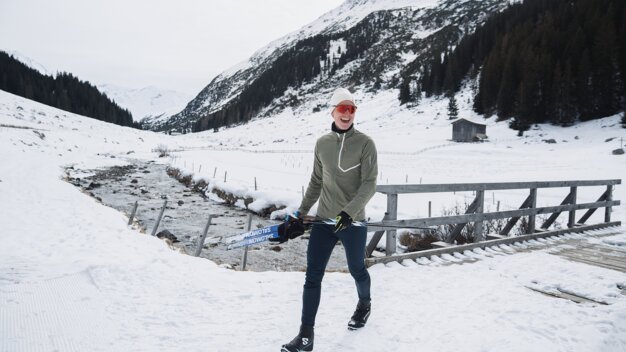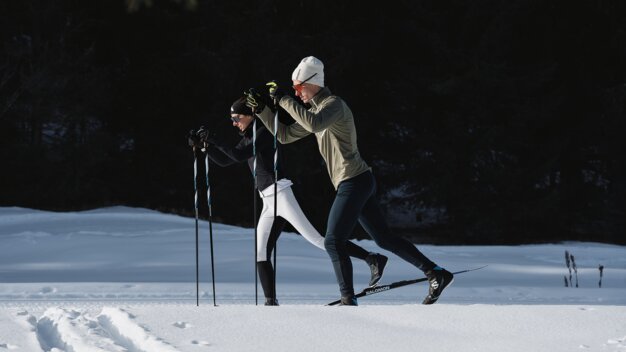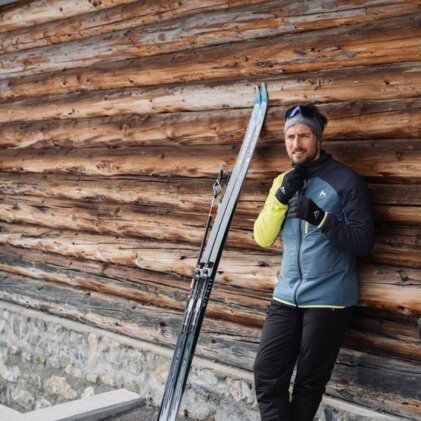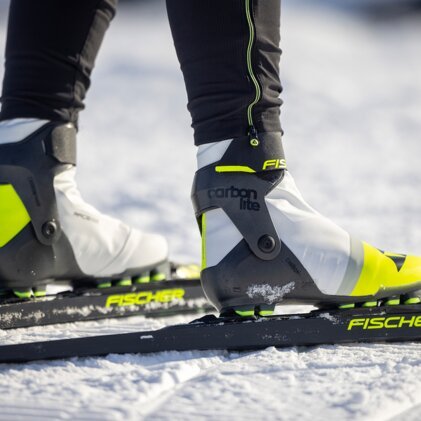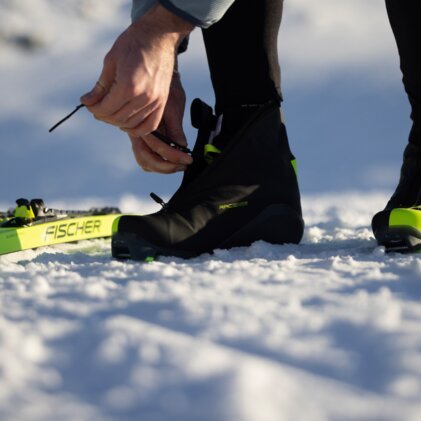
Choosing the right pole length is important for optimal performance. This is because cross-country ski poles provide propulsion. If they are too short, you will tire more quickly because you cannot generate enough thrust on the trail. If they are too long, they can even be distracting.
So what is the right choice for cross-country ski poles, and are there differences depending on your skiing style? We have done some research for you and compiled the most important information about pole length, the right material and care.
The right size for cross-country ski poles
The length of cross-country ski poles depends on the style you want to practise. Another important factor is your own height. The basic formula for the classic option is that the correct length is shoulder height. For skating style, however, they can be a little longer. Here, the guideline is between the chin and the tip of the nose.
How do I calculate the optimal pole length?
Do you like numbers? If so, we have two formulas that you can use to easily determine the correct length of your cross-country ski poles. These apply to both children and adults:
Size chart for cross-country ski poles:
| Style | Recommended pole length (formula) | Guideline |
|---|---|---|
| Classic | Body height in cm x (0.83-0.85) | Up to the shoulder |
| Skating | Body height in cm x (0.89-0.90) | Between chin and tip of nose |
If you are unsure, our RENTertainers in a shop near you will be happy to help you at any time. We look forward to seeing you.
What material are cross-country ski poles made of and which one is right for me?
Cross-country ski poles are made of different materials, and the various models can be categorised according to their weight, durability and price.
- Aluminium: These poles are beginner-friendly and attractively priced. Despite their higher weight, they are still comfortable to use and absorb minor impacts better than carbon.
- Composite: This variant is a solution made from several fibre composites. It has a multi-layer structure, with a core typically made of fibreglass. The material mix also contains carbon, which reduces weight.
- Carbon: Poles made from this material are shock-resistant and extremely lightweight. Their rigidity gives them a very high pressure load capacity and enables direct power transmission. However, they can be easily scratched, which can lead to cracks in the longitudinal fibres. Of all the alternatives, carbon models are the most expensive.
Are there any other important features of cross-country ski poles?
Another criterion in the classification of cross-country ski poles is the straps. These connect the pole to your hands. The following designs are available:
- Fixed straps: These are permanently attached to the handle. This type of loop should be adjustable to ensure a perfect fit for your wrist. The padded inserts offer the ultimate comfort for cross-country skiing.
- Removable straps: In this case, there is no fixed connection to the pole, but to your glove instead. Flexibility and the right size are essential to avoid pressure points and ensure maximum comfort. To create a secure connection to the pole, the strap can be either clicked or plugged into place.
The material used for the straps on cross-country ski poles is either synthetic fibre or leather. While synthetic materials are light and robust, leather loops are slightly heavier but offer a more pleasant feel.
How should I hold and use cross-country ski poles?
The diagonal stride is the classic technique, whereby you run in two tracks on a groomed trail. You push off with the poles in individual strokes. The cross-country skiing technique gets its name from the diagonal movement of the legs and arms.
When you push off with the left pole, your left leg should be straight and your right leg should move forward. Then, bring the left leg forward and stretch the right leg backwards. At the same time, your arms change position.
The double pole push is used in classic cross-country skiing when you want to increase your speed. This technique requires arm strength, as both poles are used simultaneously to generate speed. The legs are parallel and the knees are aligned centrally over the ski. The correct length is particularly important for this movement. If they are too short, no thrust can be generated. If the poles are too long, you will not be able to perform the movement correctly.
Hit the trails with the right cross-country skiing accessories
Every outdoor adventure has its own requirements when it comes to equipment. This could be new or different baskets for your cross-country ski poles or cleaning products for your functional clothing. In this context, it is important to familiarise yourself with this nordic sport and the care of the products. This not only ensures that the fit remains intact and performance is maintained, but also guarantees the longevity of all items. How to care for your accessories:
- Cross-country skiing clothing (jacket, gloves, etc.)
- Drying ski boots
- Fogged ski goggles
- Waxing cross-country skis
If you need help choosing the right cross-country ski poles or you need a ski service for your skis, our RENTertainers look forward to seeing you. They are the winter sports experts, who will be happy to advise you at one of our many locations.
Frequently asked questions about choosing the right cross-country ski poles
What is the difference between cross-country and alpine poles?
One of the main differences is the length. Cross-country ski poles are significantly longer than alpine models because they are actively used to propel you forward. They are also made of particularly stiff materials such as carbon to transfer power as effectively as possible. Concerning construction, they are narrower and thinner and have been designed to withstand less lateral pressure but higher compressive loads.
How long are skating poles?
The length of cross-country ski poles varies depending on your technique. While the classic style usually requires poles that reach shoulder height, skating poles should reach the area between the chin and mouth, and sometimes up to the tip of the nose. The rule of thumb for the correct length of cross-country skating poles is: body height x (0.89-0.90).
When do ski poles need to be replaced?
Ski poles need to be replaced if you are still growing and the pole length no longer matches the calculated value. However, material damage can also be a reason for replacement, as a crack in the carbon fibre increases the risk of the pole breaking. Another cause can be material fatigue, which can occur even if there is no external damage. Depending on how intensively they are used and their age, they are estimated to have a service life of 8 to 10 years.
INTERSPORT Rent tip
The RENTertainer recommends
Don't let a lack of experience or equipment stop you from cross-country skiing! At INTERSPORT Rent, you can easily rent some gear for the trails. The experts are on hand to offer advice and helpful tips for your first time in nordic sports. You will also receive useful information on the right cross-country boots and compatible binding systems.
Related articles
You may also be interested in:
